
The following article by David Strange originally appeared in The Courier-Journal on 14 Aug 2013. It is archived here with additional information for your reading enjoyment.
On Monday, July 31st, 1837, something flew across the skies of Bullitt and surrounding counties that no one around here had ever seen.
Thousands of people stood in wonder and amazement.
It was awe-inspiring. It was terrifying. It was a balloon.
In 1837, Richard Clayton brought his hydrogen-gas balloon to Louisville and became the first person to fly in a balloon in Kentucky.
Now notice that I said a "hydrogen-gas balloon." That's different than the hot-air balloons that most people in our area are accustomed to seeing today.
Recently, I had the joy of riding in a hot-air balloon myself, and I suspect that my feelings were at least partly the same as others felt way back in 1837, regardless of balloon type.
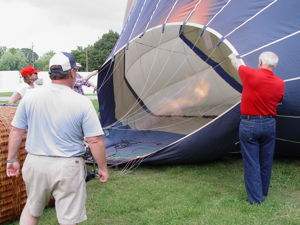
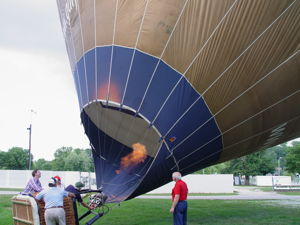
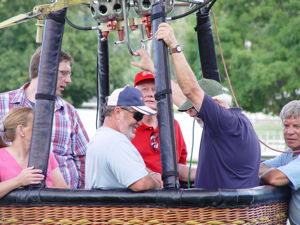
Modern-day pilot Don Conner, of "Great Flight Balloons," who piloted the balloon in which I rode, explains that our local hot-air balloons use propane gas and a powerful burner to heat the air. The hot air fills the balloon, expanding the air, and up it goes. A hydrogen-gas balloon is basically a sealed sack, filled with hydrogen, and works very much like the helium balloons that we see at parties. In fact, helium is also used for manned balloons, though mostly in the U.S.
Helium is considered safer than hydrogen. Remember the hydrogen-filled Hindenburg zeppelin disaster in which the entire airship went down in flames just before World War Two? But unlike Helium, Hydrogen is a renewable resource, made by simply dissolving iron in sulfuric acid.
I say "simply." To make enough hydrogen gas for his balloon trip, Richard Clayton used two tons of sulfuric acid, three thousand pounds of iron shavings, and ten tons of water.
But quite a trip it was! Taking off from Louisville, Clayton's balloon quickly rose and floated south toward Bullitt County. Having started late in the evening, Clayton decided to land for the night after only traveling a few miles. So he landed at a friendly farm house, apparently just "dropping anchor," as he said, for the night.
You see, that is another difference between our hot-air balloons and the hydrogen-filled balloons. A hot-air balloon requires hot air, and thus a flame, to remain afloat. A hydrogen balloon, once filled, pretty much stays filled until the gas is released or it leaks out.
Both balloon types offer spectacular views, and a surprising quietness. Clayton described it in 1837, and I experienced it in 2013. Since the balloon is really just drifting along with the wind, there is no noise; no sound of rushing air. From our lofty perch, we could see deer run across the fields; we could see rabbits scamper between the rows of corn; we could hear children (and adults) happily cry out in delight, waving and cheering us as we passed overhead.
Even in this modern day, a balloon is still a sight to see.
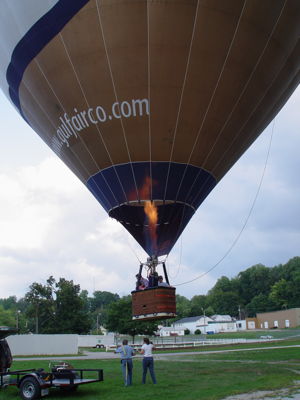
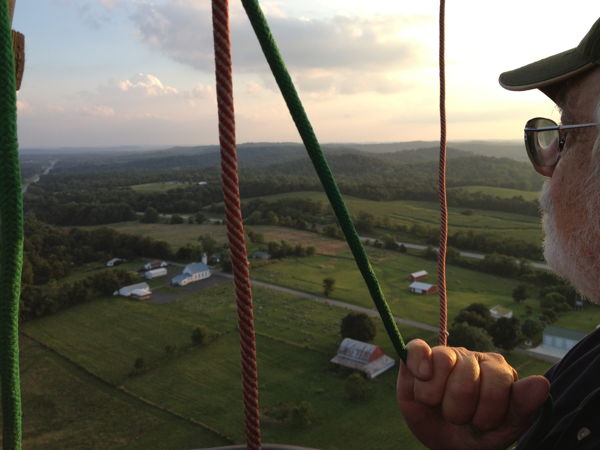
When Richard Clayton arose the next morning in 1837, he simply released his balloon and took off again. But this time the wind was blowing back toward Louisville. Riding that gentle tide, Clayton wrote that he could see the people cheering; he could hear the Falls of the Ohio River rumbling beneath him.
At about the time he came to the river, Clayton records, the wind changed again, taking him south toward West Point, near which he caught yet another wind, heading him toward Shepherdsville.
Now my flight only lasted a very pleasant hour, traveling a little more than twelve miles before we sat down in a friendly farmer's field. We had started in Corydon, Indiana, and landed on that side of the Ohio River a couple miles north of Brandenburg, not so very far from where Clayton had been.
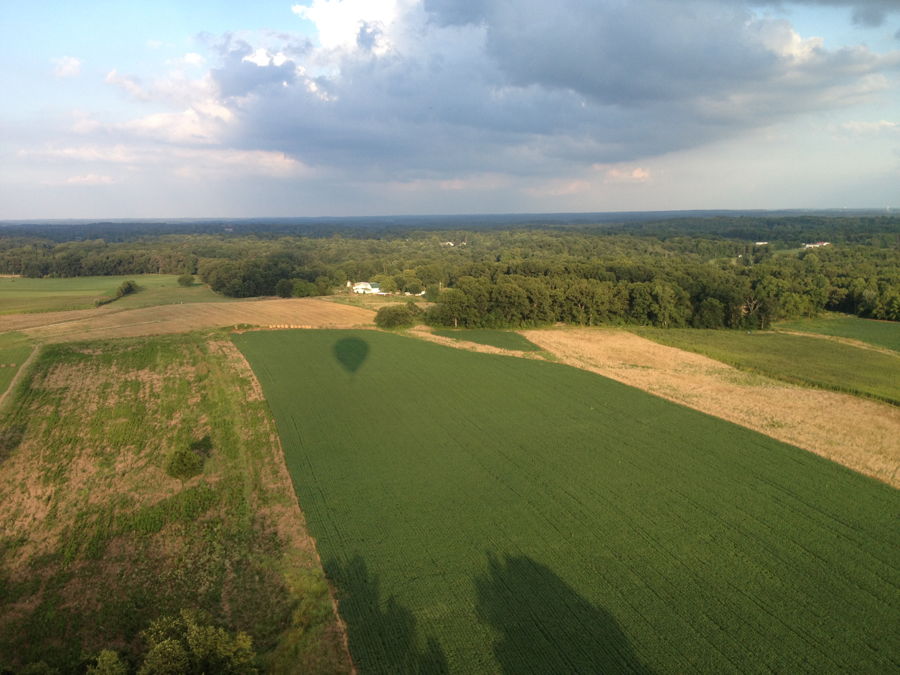
Richard Clayton, on the other hand, had many more miles yet to travel. By 10:00 a.m. on that second day, he was flying across the hills of Bullitt County with Shepherdsville and the Salt River in sight. At about 12:30 p.m. he crossed the Salt River upstream from Shepherdsville and could see Bardstown, soon dropping anchor at the home of Thomas Niles at Cane Run in Nelson County, where that family provided dinner.
On my flight, we were also dependent on friendly farmers. Don Conner found a nearly-clear field in which soy beans were just beginning to sprout. Nearby, vast fields of tall corn and more fully-grown soy beans flourished. Our choice was to either land in the relatively clear field or to take a chance on more forested land further on. A balloon does not have a lot of choice where the wind will take it, so we started down while we could. As we began to land, I was thinking that if I were a farmer, I would be at least a little irritated at such strangers coming from the sky and damaging some of my crop. But the farmer and his family came happily rushing over to greet us and to see this marvel of the air. "It's my birthday!" one of the women gleefully shouted.
Such has always been the wonder of these magnificent balloons.
Well, almost. One of the very first successful balloons, in 1783 France, caused quite a disturbance. The locals there were sure that the balloon was some demon from the sky; attacked it; and tore the balloon to pieces.
Fortunately our, and Richard Clayton's, experience was much better. Clayton's balloon did frighten some people who believed the balloon to be an evil omen, but it mostly received cheers. He, as did we, could see people from miles around coming out of houses to see such a marvelous sight. Our balloon received some disapproving stares from cows, caused deer to scatter for cover, and worried some dogs. But everyone else seemed happy to see us.
At about 3:30 p.m. Tuesday evening in 1837, after a nice dinner, Clayton went back up in the air, intending to head on to Bardstown. But the wind had again turned and was pushing him back toward Shepherdsville, and then started blowing him this way and that for some three hours, always in sight of Bardstown but not quite there.
Finally, about 7:00 p.m. Clayton gave in to the wind, landed on the farm of J. G. Wilson, at Cox's Creek in Nelson County, and packed up his balloon.
And so did we on our flight in 2013, packing up the balloon just at sunset, and heading home.
The English-born Richard Clayton was famous for his balloon flights. According to the Cincinnati Aviation Society and Museum website, the first "unofficial" airmail delivery in the United States took place in Cincinnati when Mr. Clayton carried a small sack of mail as part of a July 4, 1835 event there. In 1836, he was the first to fly in St. Louis. And then Louisville in 1837.
That first appearance of such an apparently impossible vision of humans floating along in the air must have seemed miraculous. I remember an instance twenty years ago when a hot-air balloon full of people drifted down into the small valley where I live, the riders chatting with me as they passed by. It was such a wonder to me then, even knowing the science of such a thing.
It remains a wonder to me today.
And to us all, I suppose. I think, even 175-plus years after the first balloon flight in Bullitt County, we all can't resist smiling at the sight... at the flight... of a balloon.
Copyright 2013 by David Strange, Shepherdsville KY. All rights are reserved. No part of the content of this page may be included in any format in any place without the written permission of the copyright holder.
The Bullitt County History Museum, a service of the Bullitt County Genealogical Society, is located in the county courthouse at 300 South Buckman Street (Highway 61) in Shepherdsville, Kentucky. The museum, along with its research room, is open 10 a.m. to 4 p.m. Monday through Friday. Saturday appointments are available by calling 502-921-0161 during our regular weekday hours. Admission is free. The museum, as part of the Bullitt County Genealogical Society, is a 501(c)3 tax exempt organization and is classified as a 509(a)2 public charity. Contributions and bequests are deductible under section 2055, 2106, or 2522 of the Internal Revenue Code. Page last modified: 12 Sep 2024 . Page URL: bullittcountyhistory.org/memories/balloontrip.html